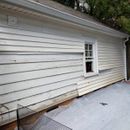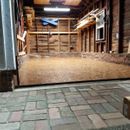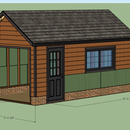Small shed reno: heating/cooling/ventilation?
iko_iko
| Posted in General Questions on
I’m starting what could be either a moderate or significant renovation/conversion of my detached shed/garage into a workshop, depending on how far I go with conditioning it. I can’t decide which direction to go. Looking for some thoughts.
Maryland suburbs of DC (Zone 4A). 10×20 garage with a rollup door. Built in the ’40s. 2×4 walls (24OC) on a ~14inch (above grade) single-wythe brick stem wall. Slab floor. Unfinished, but in very good structural shape. 2×4 rafters and 2×8 rafter ties. Original lap siding, which is covered in lead paint. Wrapped in vinyl siding since around 2002. No gable overhangs at all. Very short, but adequate eaves. Siding rises all the way to the underside of the roof deck…no venting of any sort. Front gable faces south-by-southeast.
I’ve been obsessing over the plan for this thing for 3 years, channeling all my energy into hours and hours of SketchUp, and admittedly getting a bit carried away at times. What at first looked to my eyes as a HUGE space with endless possibilities has now occurred to me to in fact be a very small space that maybe doesn’t call for quite so much work.
At a minimum, I’m installing a DriCore floor (already done), removing the vinyl (one side already done), removing all the clapboards, re-sheathing, adding a small gable overhang and then re-siding with LP, adding a man door and larger window, and replacing the overhead with carriage doors. Finally, adding a subpanel and all new wiring.
What I can’t decide on is how to condition/ventilate it, if at all. My plan all along has been to go all out: sheath with Zip, batts in the walls, some sort of insulation in the rafter bays, with baffles to allow soffit-to-ridge ventilation. Then heat/cool with a nice window unit (possibly 220v) in the rear gable.
A buddy of mine with building experience is talking me down and saying this is all overkill. And he’s gotten me wondering the same. I don’t want to go nuts for the sake of it. I just want to be able to use it year-round, no matter the weather, without too much fuss. Here in the DC area, we get long, hot, muggy summers, and winters that bottom out in the teens most years. And very short spring and fall. I don’t mind leaving it unfinished and uninsulated (using the stud bays for material and tool storage is nice), so long as doesn’t take forever to heat/cool before it’s comfy, and doesn’t waste energy.
I also need to consider my tools, including a new SawStop, and the effects of excessive humidity during the summer, when I might not go in there for days or even weeks at a time.
Let’s say I don’t bother with insulation, I still need to ventilate it in some way, no? Even if flip on the window A/C several minutes before heading out there, how quickly can it move all that hot air out?
If I DO ventilate in some way, surely that makes it more difficult to heat/cool it on those days where it’s needed, right? For instance, a ridge vent, gable vents, or a roof fan would undoubtedly make it possible to work in there on moderately warm days without running the A/C. But when I do need to run it, then what? How do you balance these two opposing forces in my situation? Vents that can be manually closed when conditioning?
If I forgo insulation altogether, is it worth it to at least mitigate with outsulation? Would going with Zip-R, rather than standard Zip, make a significant difference?
Speaking of Zip, are there any issues with using at all? My main reason I’ve been planing to use it if because I just don’t want to futz with housewrap. I want to throw these panels up and start siding as soon as possible, even if the conditioning questions have to be addressed later. I plan to tape the seams, and use the liquid flash on the door and window sills, and for sealing the bottom edges of the sheathing.
Would love some thoughts. Nice weather is finally here and I desperately want to get this done before the cold comes.
Cheers.
GBA Detail Library
A collection of one thousand construction details organized by climate and house part
Search and download construction details













Replies
I won't be able to address all you bring up, but a few thoughts:
" I don’t mind leaving it unfinished and uninsulated (using the stud bays for material and tool storage is nice), so long as doesn’t take forever to heat/cool before it’s comfy, and doesn’t waste energy."
Any form of heating or cooling 'wastes' energy in so far as it is being used for human comfort, or the comfort of human goods. If you wanted to be technical about deciding whether or not to insulate, you'd have to do a calculation based on your anticipated time spent conditioning (and to what degree) then weigh the operational energy savings with insulation added against without and compare the difference to the energy used to manufacture, transport, and install the insulation. Then you would know the energy 'pay back' of the insulation. Lots of variables.
In lieu of that calc, my gut says you'll come out ahead with at least SOME insulation if you plan to condition more than, say 'very rarely'. And there are tool rust issues to contend with too.
Using some 'exsulation' would add the benefit of thermally breaking the studs and not eating up 'internal space'.
"If I DO ventilate in some way, surely that makes it more difficult to heat/cool it on those days where it’s needed, right? For instance, a ridge vent, gable vents, or a roof fan..."
The type of ventilation you are describing is typically isolated to the attic and not the conditioned space of a house. You are right that you don't want huge holes (no less fans) allowing air exchange with the outdoors if you are conditioning the space. I would suggest checking out such articles as https://www.greenbuildingadvisor.com/article/all-about-attic-venting.
Whether you need some level of 'fresh air' venting would depend on how air-tight the structure is detailed and how nasty the air inside gets. Perhaps something like a lunos (https://www.lunos.de/en/) product or simple bathroom exhaust fan. Check out this or similar article: https://www.greenbuildingadvisor.com/article/exhaust-only-ventilation-systems
Thanks for the reply. I will definitely read those resources.
Yeah I knew the "waste energy" part was a bit of a silly thing to say the moment I posted. I guess what I meant was, given the size of this space and its purpose, is insulation making that big of a difference? Or do the downsides of fully insulating it (to the extent there are any) outweigh what might be a modest gain in efficiency, removing cost of materials from the equation. I've already budgeted to do the whole shebang. I just don't know if it's practically the best solution.
For instance, all things being equal, is it better to have a tight envelope in my climate, if I might not use the space for long periods in the summer? I'm not familiar with how humidity moves in and out of buildings with WRBs. It's the basic concepts that have me clueless here.
All I know is that currently, even with the window and main door open, it's simply too hot in there in the middle of the summer. You read my mind with the roof fan. I knew that's not traditionally used for active living space. I've just read it's a cheap and easy way to make a garage like mine tolerable in the summer. But yeah, then I thought, well what if I want to heat/cool it? I've sort of screwed myself there.
Again, I'm fine with not completely cracking this nut now. I just want to keep moving forward without delay.
Given where I am, is there any reason I *shouldn't* go ahead and Zip sheath it and consider the rest later? I only need around 13 or so sheets. I'm fine with going with Zip-R, it's not a huge cost difference. I just don't want to do anything in the short term that will limit my options as I read and learn more about proper conditioning and ventilation concepts. Plus, I'm now seeing references in other posts that Zip-R has less structural capabilities than Zip? I'm almost certainly going to be depending on the sheathing for bracing. The engineer who inspected it a couple years ago suggested as much.
Thanks again. This community is fantastic.
The best test would have been to throw a window ac unit in there on a hot day and see how it holds up- I’m guessing a 10k would have been overkill and could cool it off in 5-10 minutes.
If you’re really going to use it a lot in both winter and summer, I’d just dress up the exterior and put the insulation money towards a 6k mini split since you’ll have 220v anyways. It’ll dehumidify great, can cool it down quickly and keep it heated or maintain 50F over the winter. And will literally cost dollars to run per month. (My 2000sf house with 4 heads cost $50 to cool in a hot August).
I have a 12x20 garage as well, however it has double brick walls with cement slab ceiling and floor. Even with leaky carriage doors it stays cool all summer. 200sf should be a piece of cake to keep cool even with zero insulation.
Kevin
Funny you should mention a mini-split. Back when I still looked at this garage and saw a huge space, that's exactly what I was planning. I mentioned it to the engineer and he looked at me like I was a loon. He tried to politely make me realize that was way overkill for such a small space. That's when I realized I was inflating just how significant the garage is.
But you've got me considering it again. The sub panel is definitely happening. That's the piece I'm most excited about doing myself. Looking forward to taking the homeowner's electrical exam in my county soon so I can pull my own permits.
As for a test, I suppose I can do that now. I've got a window unit in the finished attic that I can rig up in that window and see how it does. That's a great idea. I wonder how much difference I'd see in the window vs. the gable.
Edit: oh you meant in the peak heat of the summer. Yeah that ship has sailed I'm afraid. Today was likely the last 90+ degree day of the year. Oh well.
I bet a mini-split would be better at simply dehumidifying on auto, even when I don't need to cool. That's pretty much all we use the attic unit for. I don't care if it's hot up there. I just don't want mold.
Thanks!
I'm less familiar with the climate zone you folks are dealing with, but I don't see how not insulating and running a mini-split would be considered a 'green' or economical solution vs putting in some insulation. Does the calc work out that insulation would really take that long to pay off? Or is it just a mentality of ' it's simpler to forget about insulation in favor of a good mini-split?'
Given that you're likely dealing with a good bit of heat gain from the roof, I would think having ceiling insulation, detailed well to prevent air exchange with the conditioned space, would help keep the place cooler prior even to any conditioning.
I see no reason why some zip-r wouldn't work. It may have reduced shear, but given the size of your structure I doubt that's of concern. For possible concerns with exterior foam coupled with interior fluffy insulation see: https://www.greenbuildingadvisor.com/article/calculating-the-minimum-thickness-of-rigid-foam-sheathing
But i'm guessing you wouldn't end up with too much interior fluff.
If you tape the sheathing well, and seal other air entry points (consider the transition from wall to ceiling plane), that will go a long way in managing possible moisture issues (especially with AC running in humid weather).
For my wife's studio (zone 5), I went with batts in the walls and no ceiling insulation. The place is heated and cooled with a 12k mini split, it is a modulating unit so oversizing doesn't matter much plus and it can bring the place up to temp quickly.
The energy costs are pretty small, in the wintertime, it is around $2/day. The bigger issue with no celing insulation is ice dams, when it will be reroofed, the place will get exterior insulation. If you have snow, I would definitely insulate the ceiling.
If you are re-siding, I would put 1.5" if rigid under the siding (you can hang most siding through that much rigid) and leave the walls empty. The cost of the interior plywood+batts is more than the exterior rigid and leaves the interior cavity open. ZipR is a good option but expensive. plywood+rigid is much cheaper.
One thing I did for the ceiling is raise the rafter ties. It doesn't seem like much, but bringing these up a bit made the space feel much bigger.
The most important thing overall is to air seal. For the studio, this has made the biggest difference in comfort, much more than any insulation.
Raising the rafter ties...
Yes! This is exactly what I'm planning and it's the one part that I planned on getting consultation on from the county building department. I know generally that I can raise them as long as they stay in the bottom third. But I want to be sure I'm going as high as I possibly can.
Thanks for the other thoughts, as well. I feel like I'm zeroing in on a solution here.
Cheers.
Unless you're conditioning the space at a very high duty cycle, a half-ton or 3/4 ton PTHP installed in a wall-sleeve is going to be a more appropriate solution than a mini-split in that climate. As a DIY it could run about a grand, sometimes a bit less. Figure $600-800 for the PTHP, $150 for the sleeve, plus whatever it takes for the breaker and power wiring.
A room dehumidifier set up with a drain can keep the humidity in control when you're not there. Being meticulous and obsessive about the air sealing and weather stripping details makes a difference on how much that dehumidifier would run.
An HRV makes absolutely no sense for an intermittently heated/cooled building. A 100 cfm bathroom exhaust fan operated on an occupancy/vacancy sensor switch would be fine on a room that size (overkill, really) as long as you're not using solvents & paints with the windows closed.
If it's not going to be conditioned 24/365 there's no point to foam sheathing on the walls or taking it to IRC 2018 levels too. R13 "contractor-roll" fiberglass for 2x4 framing is dirt-cheap- it would be a crime not to use it even for intermittently conditioned buildings, and it'll make it a lot more comfortable when you're there. Put OSB or plywood on the interior side if you want to hang a bunch of tools. ZIP-R is the opposite of cheap, and even the fattest ZIP-R would perform no better than R13 fiberglass in a reasonably air tight 2x4 wall.
If you're re-roofing, reclaimed roofing foam is also dirt cheap, and even 3" of used roofing polyiso above the structural deck will do more for controlling the roof gains/losses and iced damming potential than R25 fiberglass stuffed in the 2x8 rafters. Unheated or barely heated buildings don't get ice dams- heated buildings do.
Some garage doors can be relatively easily retro-fit insulated, others not so much. Most really suck from an air tightness perspective, but they can be DIY- improved.
Thanks Dana for the thoughts. Super helpful. I have some follow up questions if you don't mind.
PTHP: Why would this be a better fit than a MS? I always thought they were more or less the same tech, just in a different form factor. Are they practically a better fit, or just more economical, because of my climate? All things being equal, I think I'd prefer a MS, simply for the install flexibility. But I might be wrong about that.
Dehumidifier: If I had either a MS or PTHP, would a separate dehu really be necessary? Or did you mean in lieu of A/C? Ideally, I'd accomplish everything I need with one unit. Floor space in there is at a premium.
Insulation: It makes sense that R-13 batts would be more than enough for such a small space, and would be far cheaper than Zip-R. But again, with such a cramped space, the idea of preserving my stud bays for storage is a really attractive one. Not to mention the flexibility it gives me for rewiring as needed (tho I acknowledge that wiring in general will be more difficult, since I won't be able to span bays without any interior wall material). If I've got the budget, and I'm willing to sacrifice a certain amount of efficiency, can Zip-R be practically effective if done correctly, in lieu of any interior wall insulation? Is there a minimum thickness I'd have to get? Can I get by with 1.5" (R6.6)?
Roof: The existing roof is in really good shape, so I don't plan to disturb it, except where I need to tie in the gable overhang. What's the best option for insulating it from the inside if I want to keep the cathedral ceiling? Is a hot roof a realistic option in my zone? Are there any prefab baffles that are worth the effort?
Garage doors: I'm hoping to eventually build insulated carriage doors, adapting a few different plans I've seen here and there on the FHB site and elsewhere. If you know of any that are particularly good, please share.
Thanks again. Cheers. -r
>"PTHP: Why would this be a better fit than a MS?"
Because it's an intermittent use application, and not dramatically less efficient in your climate and application than a mini-split. With intermittent use applications you want a bigger oversize factor to bring it up/down to temperature quickly. With a mini-split that means it would be spending most of it's power running at max speed, not idling along in a super-efficient modulating mode, which is where you get the most benefit out of them.
Another aspect is that the refrigerant system is all self contained in a single crate, where the lines can't be damaged, and with no flared connection fittings, with less likelihood of leaks. For only slightly more money than a PTHP you could get a DIY-type mini-split, but the reliability factor is somewhat lower on a DIY mini-split due to site assembly factors, whereas the refrigerant loops of a PTHPs are assembled & sealed in controlled factory conditions.
It's easy to make minor screw ups with a mini-split installation that have consequences sometimes years later. It's really hard to screw up a PTHP installation (though the more idiot-proof you make something, the more creative the idiots become. :-) )
>"Dehumidifier: If I had either a MS or PTHP, would a separate dehu really be necessary? "
Yes, especially if you're going to let the sensible temperatures stagnate at some higher or lower temperature when the buildging is not occupied, which would be the most energy-efficient thing to do.
>"It makes sense that R-13 batts would be more than enough for such a small space, and would be far cheaper than Zip-R. But again, with such a cramped space, the idea of preserving my stud bays for storage is a really attractive one."
----
>"If I've got the budget, and I'm willing to sacrifice a certain amount of efficiency, can Zip-R be practically effective if done correctly, in lieu of any interior wall insulation? Is there a minimum thickness I'd have to get? Can I get by with 1.5" (R6.6)?"
If you have the budget for 1.5 ZIP-R you have the budget for 2" of reclaimed roofing polyiso strapped onto the exterior of half inch or thicker OSB/CDX sheathing, with 1x4 furring through-screwed to the studs, fastening the siding onto the furring. That would outperform 1.5" ZIP-R by about 2x, would likely cost less, and would be a more resilient assembly if you deal with the window flashing and WRB correctly. The performance would be about 15% higher than the simpler 2x4/R13 wall.
ZIP-R would need interior side thermal barrier against ignition to meet fire codes, and even if you're willing to take that risk, the polyiso would be exposed to the stud bay and subject to damage if your storing tools on shelves or hooks in the stud bays. Cutting half-inch gypsum board to fit and gluing onto the interior facing side of the ZIP-R would be one method of dealing with those issues if going that route.
>"Roof: The existing roof is in really good shape, so I don't plan to disturb it, except where I need to tie in the gable overhang. What's the best option for insulating it from the inside if I want to keep the cathedral ceiling?"
3.5" of open cell foam between the rafters, with half-inch gypsum painted with vapor-barrier latex would be one approach. If you have soffit-to-ridge venting you could install vent chutes and R8 (2.5" thick) batts between the rafters, and 2" layer of polyiso cap-nailed to the rafters before long-screwing on the ceiling gypsum (necessary as a thermal barrier) with 3.5-4" bugle heads. That would deliver about the same performance as an exterior layer of 3" roofing polyiso.
>"Are there any prefab baffles that are worth the effort?"
Cheap & effective, better than most foam versions:
https://jrproductsinc.com/product/cardboard-attic-baffles/
The baffles could end up costing as much as the R8 batts (usually sold as sound attenuation batts.)